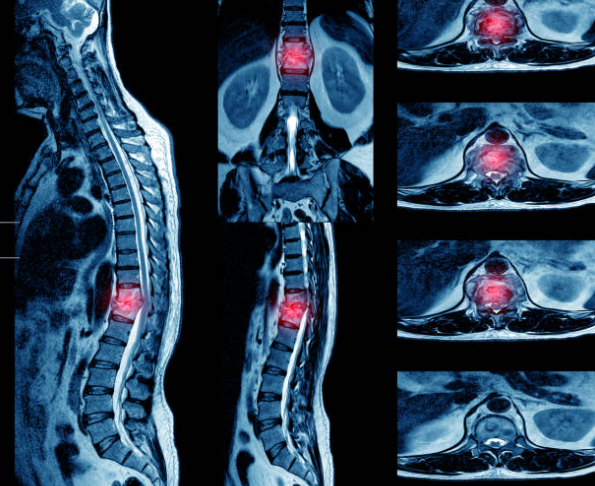Spinal tuberculosis also known as Pott’s disease or tuberculous spondylitis is a serious infection of the spine caused by the bacteria Mycobacterium tuberculosis. Early diagnosis and treatment are crucial in preventing severe complications associated with this condition. This article provides a comprehensive guide of Spine TB Symptoms, neurological signs and complications of spinal tuberculosis helping you recognize the early warning indicators of Pott’s disease.
What is Spinal Tuberculosis?
Spinal tuberculosis (spine TB) occurs when tuberculosis bacteria spread from other parts of the body most commonly the lungs to the spine. This infection can severely damage the spinal bones (vertebrae) and the spinal cord if not detected early. Recognizing the symptoms of spine TB early can significantly improve treatment outcomes and reduce the risk of complications.
Spine TB Symptoms
1. Persistent Back Pain
One of the earliest and most noticeable symptoms of spinal tuberculosis is persistent back pain. This pain is different from regular muscle strain and tends to be more intense and long-lasting.
- Localized Pain: The pain typically affects the lower or mid-back region where the spinal TB infection most commonly develops.
- Worsening Over Time: Unlike other types of back pain the discomfort caused by tuberculosis infection tends to worsen progressively even with rest and standard pain relief measures.
2. Neurological Symptoms
As the infection progresses it may compress the spinal cord or nearby nerves leading to various neurological symptoms:
- Weakness in the Limbs: Weakness in the arms or legs can make it difficult to perform daily activities indicating nerve involvement.
- Numbness or Tingling: Sensations of tingling or numbness in the limbs are common as the infection impacts the nerves.
- Loss of Bladder or Bowel Control: Severe spinal tuberculosis can lead to a loss of control over bladder or bowel functions due to significant nerve damage.
Signs of Pott’s Disease and Deformity
3. Visible Spinal Deformity (Kyphosis)
In advanced stages of spinal tuberculosis a visible spinal deformity known as kyphosis may develop causing the spine to curve abnormally forward.
- Hunchback Appearance: Kyphosis creates a noticeable hunchback look, a clear sign of severe damage to the spine caused by the infection.
- Risk of Paralysis: If left untreated this spinal deformity can compress the nerves further potentially leading to paralysis.
Systemic Symptoms of Tuberculous Spondylitis
4. Fever Night Sweats and Weight Loss
Besides localized back pain spinal tuberculosis often presents systemic symptoms that can affect the entire body similar to those seen in general tuberculosis:
- Low-Grade Fever: Persistent fever particularly at night is a common symptom of spinal tuberculosis.
- Night Sweats: Profuse sweating during the night is frequently reported.
- Unexplained Weight Loss: Sudden and unexplained weight loss may occur as the body struggles to fight the infection.
5. Cold Abscesses in Spinal Tuberculosis
Cold abscesses are another significant feature of Pott’s disease different from typical abscesses seen in bacterial infections.
- No Heat or Redness: Unlike common abscesses cold abscesses do not display warmth or redness making them more challenging to identify.
- Spread to Other Areas: These abscesses can sometimes extend into nearby muscles or even the abdomen complicating the infection further.
Diagnosing Spine TB Symptoms Early Detection is Key
Early diagnosis of spine TB is crucial to avoid severe complications like spinal deformities or neurological deficits. A combination of physical examinations, imaging tests and laboratory analyses is typically used for an accurate diagnosis.
- Imaging Tests: X-rays MRI and CT scans help detect vertebral damage and the presence of abscesses.
- Laboratory Tests: Blood tests and analysis of tissue samples from the affected area confirm the presence of tuberculosis bacteria.
Risk Factors and Causes of Spinal Tuberculosis
Understanding who is most at risk for spinal tuberculosis can help in early detection and prevention:
- Weakened Immune System: Individuals with compromised immune systems such as those with HIV/AIDS or diabetes are more susceptible to spine TB.
- History of Pulmonary TB: People with a history of lung tuberculosis are at a higher risk of developing spinal TB.
- Living Conditions: Crowded living conditions or exposure to others with active tuberculosis increases the risk.
- Obesity and Spine Health: Obesity can put additional strain on the spine, making it more vulnerable to infections and structural issues. To learn more about how obesity affects spine health, you can read The Impact of Obesity on Spine Health.
Importance of Recognizing Symptoms of Spinal Tuberculosis
Identifying spinal tuberculosis early is essential to prevent severe complications like paralysis or permanent spinal damage. Treatment usually involves long-term antibiotics and in severe cases surgery may be needed to stabilize the spine and relieve nerve compression.
Final Thoughts
Understanding and recognizing the symptoms of spinal tuberculosis including persistent back pain neurological signs and systemic effects is key to early intervention. Do not ignore these warning signs and seek medical advice immediately if you or someone you know is experiencing any of these symptoms. Early diagnosis and treatment are crucial in effectively managing this potentially debilitating condition and preventing lasting damage.




